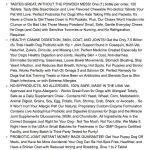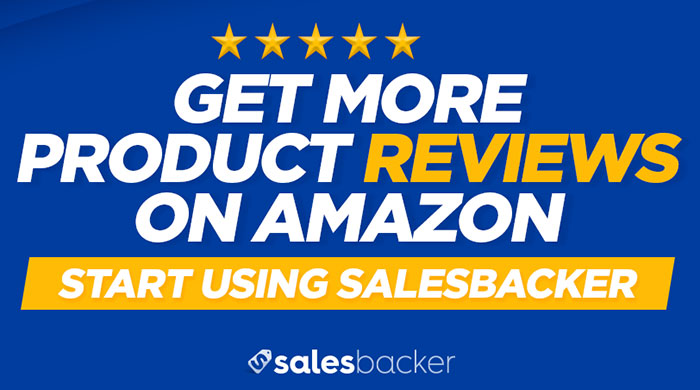Creating a product that is different from the competition is important but in order to make sure your product sells you will need customer reviews. Try Salesbacker for free so that you can automate the process of asking your customers for product reviews.
Now whether you’re getting ready to launch your first Amazon product or you’re thinking about bringing on a second one, you need to think about differentiation. If your product doesn’t stand out from your competitors by some significant difference, you’ll find that sales are difficult to come by. Differentiation is what helps customers notice you.The last thing you want is to blend in with every other similar product on the shelf.
The problem is that so many Amazon sellers are often selling basically same product as their competitors. They’re not using proprietary technology or a secret formula. They’re simply finding a manufacturer who makes a product within the niche, then trying to sell it for themselves.
I want to give you eight ways you can differentiate your product from your competitors, and to do so, I’ll use an actual Amazon example. We’re going to go shopping for…(drumroll)...a new fanny pack. I’ve actually never owned one, but I’m wanting to up my street cred. And I can’t think of anything that says “party animal” like a fanny pack.
So follow along with me as we explore the competitive niche of fanny packs. Along the way, you’ll see what each brand is doing to try to stand out and be noticed by potential customers (like ourselves).
Let’s get shopping!
EIGHT WAYS TO DIFFERENTIATE YOUR PRODUCT FROM COMPETITORS
1. You can differentiate your product by size
So when I searched Amazon for “fanny pack”, this brand stood out to me on the first page.

It wasn’t because of the picture (although it’s professionally done). It was due to a single word in the product title - “Small”. Now usually we think that pointing out something is small is a negative. Who wants small when you could have big? But in this case, I’m really not interested in wearing a large, bulky bag around my waist when I’m out clubbing on Saturday night. What if I start dropping it like it’s hot but am impeded by a gigantic sack around my midsection?
Then again, maybe my fanny pack should be big so the ladies notice it when I walk onto the dance floor? Here’s another brand who highlights size as their differentiation:

It’s the complete opposite from Superbicycle’s approach, but it’s still a way to be different. And there’s probably someone from Texas who’s trying to find something big enough to carry their revolver in.
So in the fanny pack niche, these brands decided to stand out in the crowd by being different in size. You may be able to do the same with your own product. Could you offer more tablets in the bottle? Could you make your product three inches longer than your competitor? Or three inches smaller? Could you emphasize that yours is “lightweight” or “streamlined” or “slim”? Sometimes, the product may be the same size as others, but none of your competitors are using the title to emphasize the size aspect.
2. You can differentiate your product by origin
This won’t apply to everyone selling on Amazon, but it applies to more sellers than you realize. Check out this fanny pack which pops up on the first page search results:

Now there’s a differentiating feature that very few fanny packs are able to claim! “Handmade in Guatamala”. Now sure, they may not be able to spell the word Guatemala correctly (it’s an “e” after the t), but their product is standing out on the shelf because they highlight its origin. This also explains why so many Guatemalans are telling me I need to buy a fanny pack.
Of course, you might not be able to source your product from a small group of villagers in Bangladesh, but you may be able to simply throw in the origin of your product as a differentiator from your competitors. For example, this dog company could have easily named their brand “Pet Naturals”, but instead they included an origin word Pet Naturals of Vermont. And for some reason that just sounds more safe, more down-to-earth, more natural, and different.
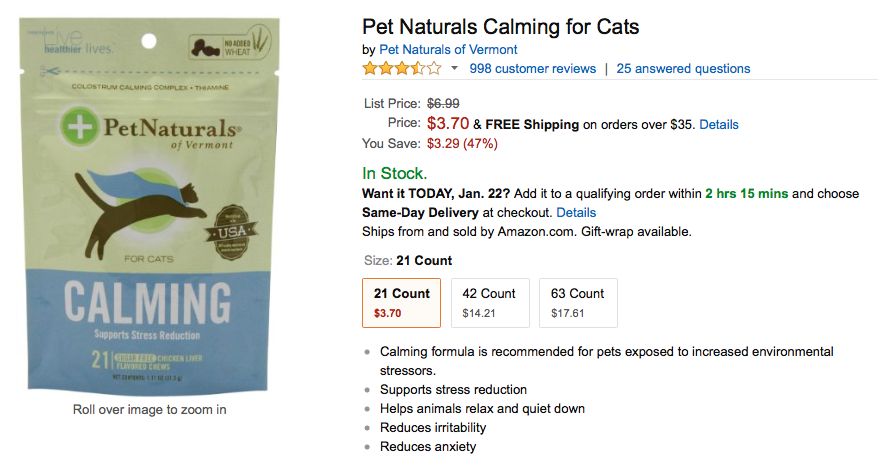
Is your product manufactured in a specific state, country, or region that you could highlight in your title or brand? It may be that a competitor sources from the same place, but you can feature the origin to help your product get noticed.
3. You can differentiate your product by branding
Branding is not a guarantee for increased sales. You can hire the best graphic designer, but if you put the greatest logo on a shoddy product, you won’t go far.
However, if you realize that your product is essentially the same as your competitor, you might be able to gain the upper hand with better branding. What’s inside the cup may be the same, but you can decorate the cup better.
So when I’m searching for a fanny pack, the brand that holds the number one slot is Everest.
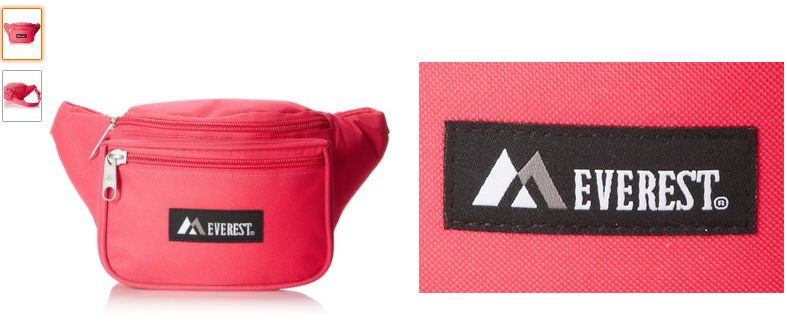
Everest is actually a brand that offers a full product line of luggage, so they’ve developed a reputation for knowing what hikers and travellers need. But the branding Everest uses is also very effective. It’s simple, clean, and evokes a sense of durability and exploration. This would allow me to wear a fanny pack and deceive my friends into thinking I’m planning on doing some dangerous wildlife stuff in the very near future.
Compare that branding with another fanny pack company - Bridger Supply.
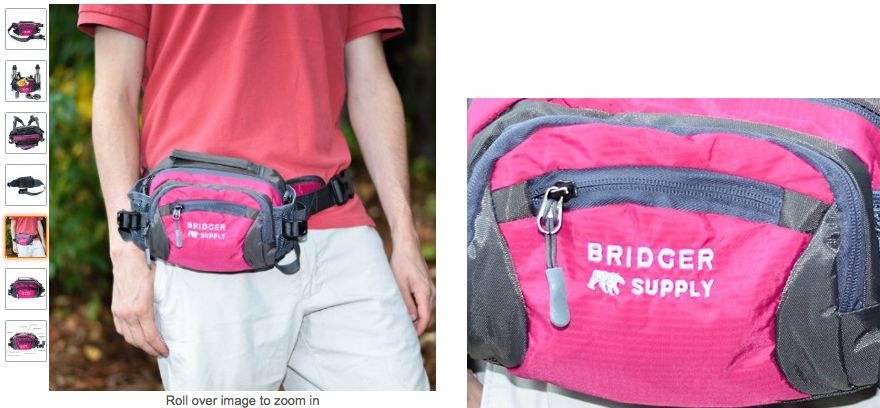
Now it’s not that Bridger Supply is a poor company. And I’m not picking on it just because they put a pink fanny pack on that adolescent boy wearing a salmon colored shirt. Everest’s advantage over Bridger (in my opinion) is branding. While Everest’s design is clean, recognizable, and emotive, Bridger’s branding is too simplistic and their name doesn’t evoke any specific feelings of trust.
If you’re trying to compete against a similar product, placing more creative energy into your branding may help gain you the advantage. If this is something above your paygrade, you might want to invest in hiring someone proficient in the field.
4. You can differentiate your product by your packaging
Now I can’t really give you a good example of this in the fanny pack business because packaging a fanny pack is pretty standard. So let’s go back to Pet Naturals of Vermont. Look for their product in these search results and notice how their packaging stands out.
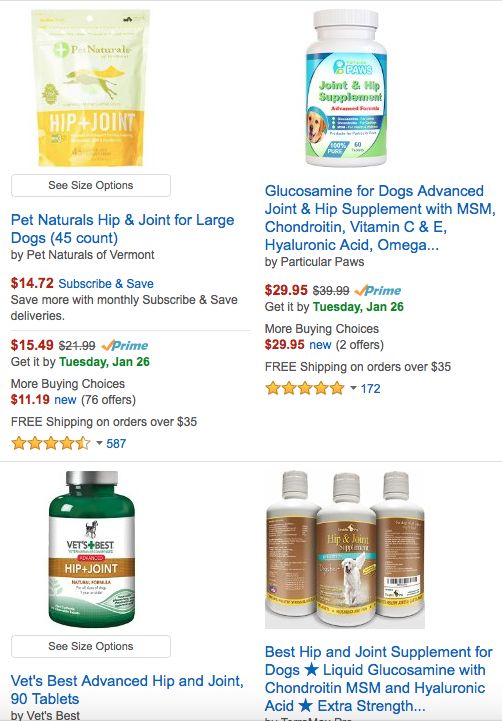
While so many of their competitors are selling their product in a bottle, Pet Naturals of Vermont decided to package in a bag. This not only cut down on their overall cost, but it also offers them a way to stand out from their competition. In my opinion, it comes across more biodegradable and eco-friendly, and when you’re using the word “Naturals” in your brand, that’s a good thing.
Think through your own packaging and ask yourself if there is a way you could alter the packaging to make it stand out on a crowded shelf. Could you sell your product in a cup instead of a bottle? A tube instead of a polybag? Could your packaging be formatted into a unique shape? Could your packaging give the appearance of a high-end label or an eco-friendly option?
Keep in mind, you don’t want to be so far out of the box that customers are scared to try your product. But at the same time, your creativity in packaging could go a long way to getting noticed in a page full of search results.
5. You can differentiate your product by adding a simple feature or ingredient
If your manufacturing source has the ability to customize your product, you may be able to differentiate your product by adding one simple feature or ingredient. It doesn’t necessarily have to be a major change, but one single change in the design could be a great contrast to other brands.
So take a look at Sunhiker’s fanny. Sorry. Sunhiker’s fanny pack. What feature did they add to make their product stand out?
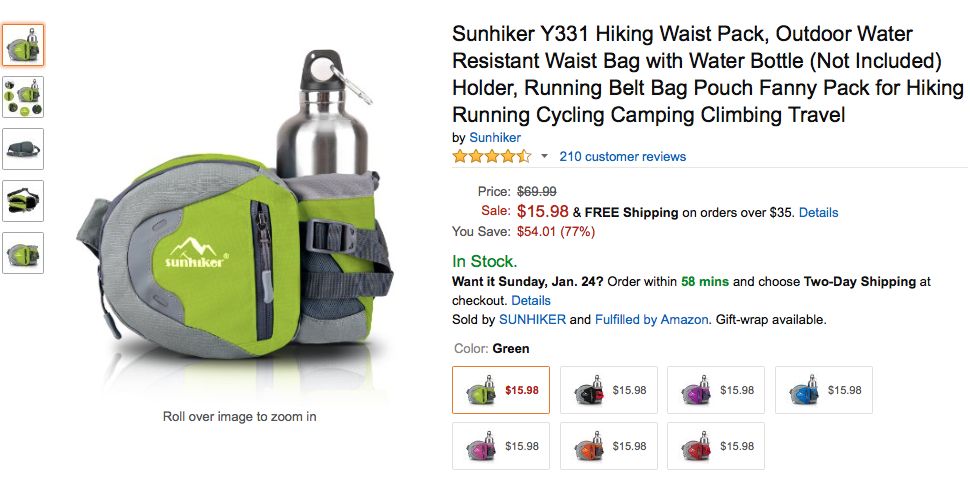
Sunhiker designed their fanny pack with lots of great features (water resistant, compact, various colors, etc.) but lots of other brands offer those same features. It’s the “Water Bottle Holder” that makes them stand out. In the first two pages of search results, they’re the only company that offers this feature.
Sometimes your product can be easily tweaked by adding one simple feature that doesn’t hurt your overall manufacturing cost. Velcro instead snaps, bacon flavored instead of liver, unscented instead of scented, expandable or adjustable instead of stationary, reinforced stitching instead of standard, weather resistant, even simply changing the color - the possibilities are endless.
Is there one simple modification you can do for your product that causes customers to take notice?
6. You can differentiate your product by offering a bonus
If you’d like to make your product stand out among your competitors, you might try adding to your offer. It doesn’t have to eat up your profit margin, but your bonus product simply adds a little extra value to your primary product. Here’s a great example from a fanny firm called Elite Goods.
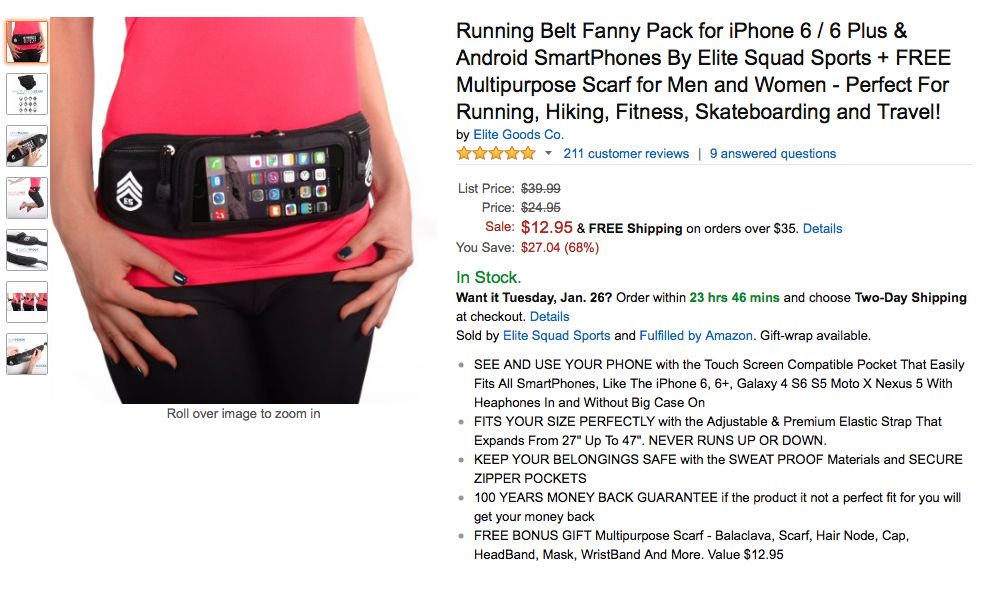
Notice what they’ve done. If you purchase their fanny pack, you’ll get a “multi-purpose scarf” as a bonus product. Now I can think of a lot of purposes for a scarf - keeping your neck warm, hiding my true identity, choking out rival gang members - but regardless, the message is clear: “We’ll give you two products for the price of one!” That somewhat subliminal message can go a long way for some customers.
You’ve seen this a million times on infomercials and tv advertisements. “But wait...there’s more! If you buy right now, we’ll throw in…” So could you create a “but wait...there’s more” for your product?
Is there a small item that could be sourced cheaply in bulk that you could have inserted into your product. As an example, check out this fanny pack for lifeguards (or fans of David Hasselhoff):
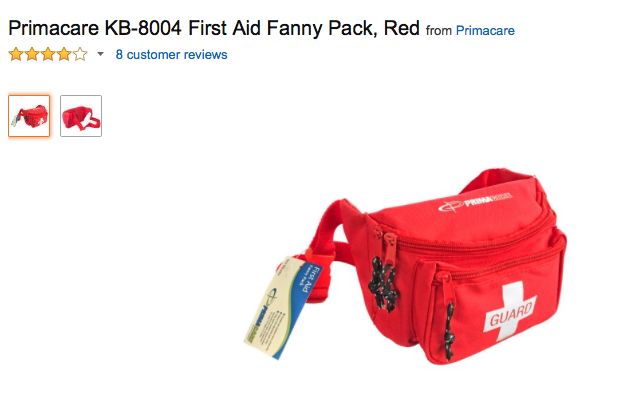
Since you’re obviously targeting lifeguards, could you not throw in a cheap whistle that could easily be placed inside the pack? Maybe a small sample of sunscreen? An 8x10 of The Hoff? Someone looking for a lifeguard pouch may be persuaded to by this one since they could use the other product anyway.
Digital content is also a great way to offer an extra item that delivers value to your customer but doesn’t break your bank. Do you have a monthly newsletter? Offer a “free subscription” to it. Are you an expert in your field? Offer a free e-guide that supplements your product. Could you create a digital calendar that each customer automatically receives in their inbox after ordering? Because who wouldn’t want a digital calendar of “Famous Fannies of 2016”?
By offering a little something extra to customers who purchase, you provide a little extra incentive for shoppers to consider your product.
7. You can differentiate your product by highlighting a feature
This option is probably the easiest but most overlooked way to set your product apart from others. To make it easy to understand, let’s take a look at a good example from two different fanny factories:
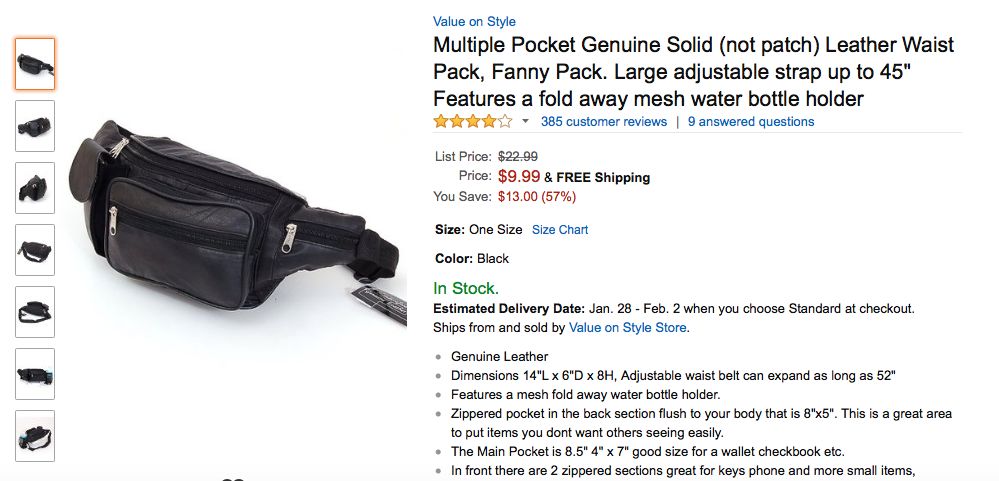
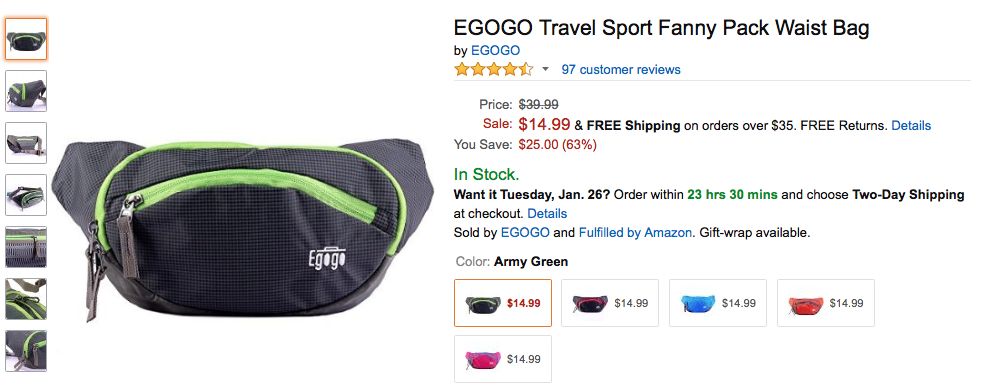
Notice that the first fanny pack by Value on Style (not very creative, but straightforward) is advertising a feature that customers may be looking for - “Large adjustable strap up to 45”.” Trust me, I’ve seen lots of big-boned individuals sporting fanny packs at Disney World, and the words “large” and “adjustable” are important to them.
But now look at the second pack by Egogo. It’s for “travel”, “sport”, your “fanny”, or your “waist”. But if you shop in the Big and Tall section, you’re wondering, “Will it wrap around me?” The interesting thing is that the Egogo pack actually has a longer strap than the Value on Style. The only difference? You’d have to scroll down to the product questions section of Egogo’s listing to find that out.
It’s the exact same feature, but only one seller is highlighting it. Can you do the same? Is there an ingredient in your mix that no one else is talking about? Research the benefits of the ingredient and make it a bullet point or place it in your title. Is there a size feature that you can play up on that may lure potential customers to your list (extra large, extra long, mini, giant)? Is your product made out of a specific kind of material?
The more you think about the features of your product, the more likely you will discover one of these can be promoted as a differentiation. And the best thing is, you don’t have to pay for it since it’s already in your product.
8. You can differentiate your product by exposing the weaknesses of other brands
If you’re looking for a place to get some ideas on how your product can be different from your competitors, there’s no better place to look than their own customer reviews. As you browse through their customer’s comments, you should be looking for any common weaknesses in their product. These weaknesses can become great ideas for your product titles, bullet points, and descriptions.
For an example of this, let’s go back to Egogo (mainly because I like how it sounds). As I started to look at the negative reviews of their customers I came across this specific complaint: “...the belt clasp slips after it has been adjusted which requires frequent readjustment.”
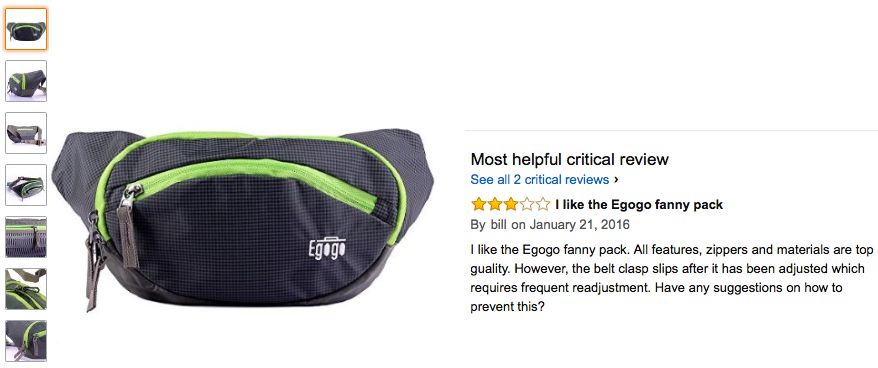
Now if this is only mentioned in one review and others rave about the security of the belt clasp, it wouldn’t be worth my time to use it. But if multiple reviewers are all having slippage problems, I’ve found a weakness I can capitalize on. Now I can adjust my own listing to mention our “non-slip” clasps or market our straps as “anti-slip” or “slip-proof”.
If you’re still struggling to come up with your own differentiation, pick out three of your competitors and read through their reviews. Look for a common complaint, then see if you could use those complaints to inform your own listing. Do customers complain about a “chalky” taste? Do they not like the heaviness of your competitor’s product? Does the other product stain easily? Is your competitor’s product effective but a hassle to use? Suddenly your own products are non-chalky, light, stain-resistant, and hassle-free.
Conclusion
Imagine that your product was being purchased by a big-box store and placed onto their shelves to sit beside five other major brands selling a similar product. Why would a customer look over the entire shelf, then reach out and choose yours to purchase? Answering that question will start you on the path to creating major differentiation.
In some ways, Amazon is an even harder scenario. No, you’re not on a physical shelf, but you are competing against hundreds of other brands trying to attract customers. If your product, labeling, packaging, and listing are simply imitations of a better company, you’re giving customers no reason to even notice yours in the search results.
Walk through each of the eight ways of differentiation and determine where the greatest possibilities lie for your product. It will take time and effort, but the investment will be well worth it when customers start paying attention.
And if you’re trying to spot me in the club tonight, look for a hot pink fanny pack getting jiggy with it.
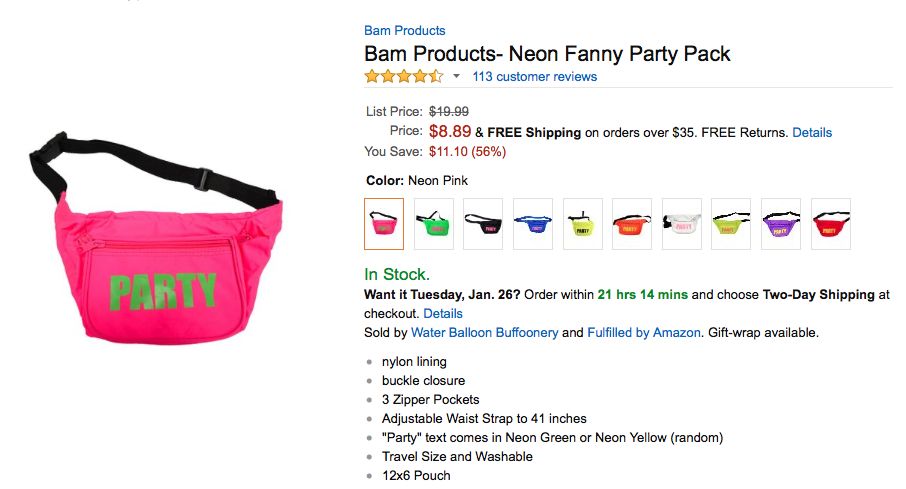
Remember no matter how great your product is, customers will not buy it if they don't see social validation in the form of product reviews. Getting product reviews is incredibly important and one of the best ways to do that is by using Salesbacker. It's free to try, takes minutes to set up one time and you're done. Click here to start.


